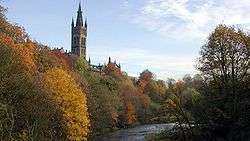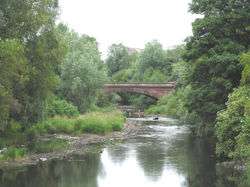Scottish Exhibition of National History, Art and Industry
The Scottish Exhibition of National History, Art and Industry was held in Glasgow in 1911. It was the third of 4 international exhibitions held in Glasgow, Scotland during the late 19th and early 20th centuries.

Summary


The exhibition followed the lead of the previous two exhibitions (Glaswegian exhibition (1888) and Glasgow International Exhibition (1901)) and took place at Kelvingrove Park. It ran from 2 May to 4 November[1] 1911, and recorded over 9.3 million visits.[2]
Exhibits
The fair was held close to the River Kelvin structured around the Stewart Memorial and included a Palace of History (based on the Falkland Palace,[3] a Palace of Industry, Concert Hall and an Aviation Building.[4]
Entertainments included boat trips, an aerial railway and a Highland Village (from which a cairn marking the village remains).[5]
Legacy and remnants
The land used is now a park.
Profits from the fair were used to fund the establishment of a Chair of Scottish History and Literature at the University of Glasgow the post was originally filled by Robert Rait and is now occupied by Edward J. Cowan.[6]
See also
- International Exhibition of Science, Art and Industry (1888)
- Glasgow International Exhibition (1901)
- Empire Exhibition, Scotland 1938
- Glasgow Garden Festival (1988)
External links
- http://www.studygroup.org.uk/Exhibitions/Maps/1911%20Glasgow.jpg - site map
- http://www.theglasgowstory.com/imageview.php?inum=TGSE00391 photo from the University overlooking the exhibition site part way through construction
References
- ↑ "THE SCOTTISH EXHIBITION OF HISTORY, ART AND INDUSTRY - GLASGOW 1911". Retrieved 12 March 2011.
- ↑ "University of Glasgow :: Story :: Biography of Scottish Exhibition of National History, Art and Industry". Retrieved 12 March 2011.
- ↑ "THE SCOTTISH EXHIBITION OF HISTORY, ART AND INDUSTRY - GLASGOW 1911". Retrieved 12 March 2011.
- ↑ "Glasgow Exhibition 1911". Retrieved 12 March 2011.
- ↑ "Kelvingrove Park Heritage Trail 21-24". Retrieved 12 March 2011.
- ↑ "University of Glasgow :: Story :: Biography of Scottish Exhibition of National History, Art and Industry". Retrieved 12 March 2011.
| Preceded by Glasgow International Exhibition |
World's fairs held in Glasgow 1911 |
Succeeded by Empire Exhibition, Scotland 1938 |